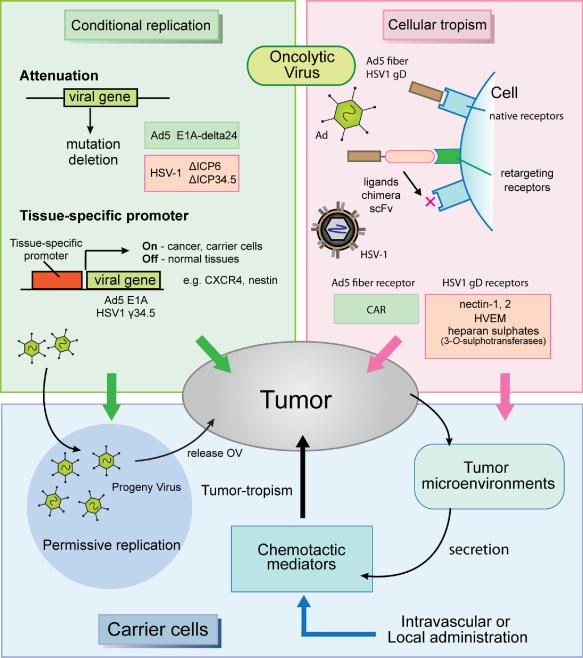Fig. 1.
Schematic overviews of the carrier cell-based oncolytic virus (OV) delivery to tumors. Cellular tropism (purple shaded region): Cellular internalization of Adenovirus serotype 5 (Ad5) and herpes simplex viruses type 1 (HSV-1) depends on cellular receptor expressions: Coxsackie and Adenovirus Receptor (CAR) for Ad5 fiber and nectin-1, 2, HVEM and several 3-O-sulphotransferase-modified heparan sulphates for HSV-1 gD . Cellular retargeting is achieved by viral ligand modifications by means of covalent linkage to peptides that can target cellular receptors, by using chimeras with other adenoviral serotype proteins or by using single-chain antibodies (scFv) to link adenoviral entry to a specific cellular receptor. Conditional replication (green shaded region): Ad5 E1A mutation and transcriptional regulation by tissue-specific promoter (e.g. CXCR4) achieve conditional viral replication. Tumor-specific HSV-1 replication is based on the deletions of UL39 gene (ICP6) and/or γ34.5 genes (ICP34.5), and conditional γ34.5 gene transcription by tumor-specific promoters (e.g. nestin). Carrier cells (blue shaded region): mesenchymal/neural stem cells (MSC, NSC), immune cells (T cells), or cancer cells themselves have been used as carrier cells to deliver Ovs, usually through intravascular (intravenous and carotid artery) or local (e.g. intracranial) administration. Carrier cells can migrate to tumor beds attracted by chemotactic mediators secreted from the tumor microenvironment. Carrier cells allow OV replication to release progeny OVs toward tumors.

